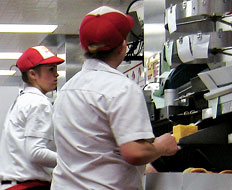With 12.8 million workers, the restaurant industry is one of the largest employers in the country. Industry champions often boast of the distinction, and particularly now, with national unemployment at 9.1 percent, it appears as if the restaurant industry is playing a hefty role in the U.S. labor market.
Of course, people who have had their eye on the industry for a while remember a time, before the Great Recession, when it wasn’t easy to recruit quality employees or even a full staff.
“Anyone who’s been around the business for any length of time knows that there have been times when it was all but impossible to get people to work in a fast food and quick-service environment,” says Christopher Muller, the dean of Boston University’s School of Hospitality Administration and a fourth-generation restaurateur.
“I’m here in Boston,” Muller says. “Back in the ’80s, Burger King and McDonald’s were busing people in from 50 miles away and offering them [well above minimum wage] because they just couldn’t find enough employees.”
At a time when there are more people unemployed in the U.S. (13.9 million, according to the Bureau of Labor Statistics) than there are employees in the restaurant industry, brands need not worry about the supply of willing workers running low any time soon, let alone about renting any buses.
But even in a labor market flush with supply, restaurants need to look ahead and determine if they are poised to attract the top talent they need to thrive once the economy improves and the labor pool shrinks.
And Muller isn’t sure that they are.
“We have a very tenuous relationship with our workforce because we treat our workforce in many cases as expendable, and that’s not to our competitive advantage,” he says.
“We need to professionalize the industry so that people can stay in the job.”
Muller is referring to the notoriously high rate of employee turnover in the restaurant industry. During the better part of last decade, the median turnover for a quick-serve crew member was more than 100 percent on an annualized basis—meaning the average nonsupervisory employee at a quick-service restaurant left his or her job within a year.
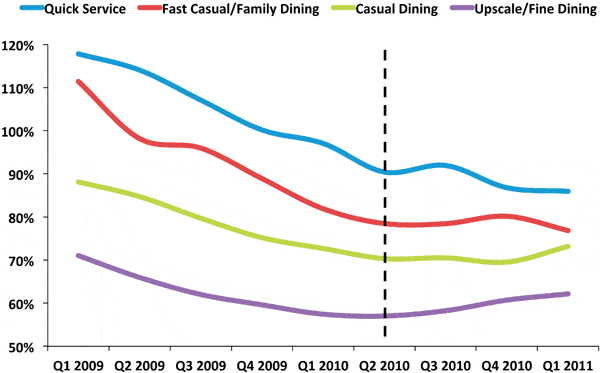
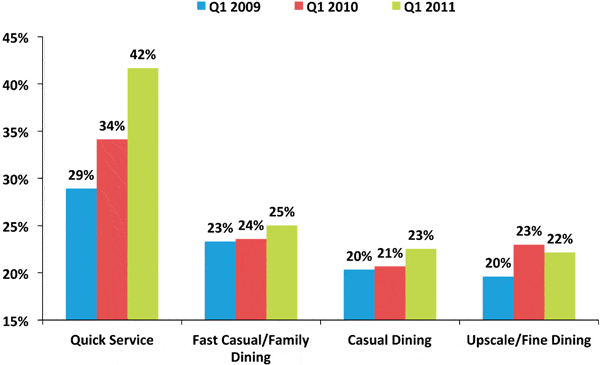
That number dropped to 85 percent in 2010, and it is at 80 percent so far in 2011. The drop is an indication of the obvious—people with jobs are clinging to them at a time of high unemployment—rather than of a fundamental change in restaurant competitiveness in the labor market.
Still, in the last two decades, many restaurant chains have reckoned with the public perception that working at a fast food restaurant was a bum job. For example, the industry’s top dog, McDonald’s, has pushed hard and effectively against the stigma of the “McJob,” a term that came to denote any low-pay, dead-end job, not just ones at the chain itself.
[pagebreak]
In fact, McDonald’s managed to partially subvert the term both through marketing and by offering its employees more opportunities for career advancement. Evidence of the latter is that half of McDonald’s franchisees and 75 percent of its managers started as store workers, stats the company proudly proclaimed in the lead-up to its inaugural National Hiring Day on April 19.
While people may disagree on how effectively restaurants are competing in the labor market, nearly all agree that providing prospective employees with a clear path to advancement is a crucial factor, perhaps even more so than wage.
“You need a competitive wage to get somebody into your organization,” says Tom McMullen, vice president and North American reward practice leader of Hay Group, a consulting firm. “You need to be within spitting distance of your competitors just to attract someone to go work for you.
“But just having a competitive wage, and even a competitive benefits program, won’t be the primary vehicle that you have to retain these folks,” McMullen says. “The key thing that retains people in a job is … ‘Do I feel that I have long-term potential around here?’”
The average nonsupervisory employee makes $8.92 per hour, or $1.67 more than the national minimum wage of $7.25. This means that restaurant nonsupervisory employees who work full-time all year long make, on average, less than $16,000 per year.
This yearly figure is well above $10,890, which is the 2011 U.S. poverty line for an individual, but it is hardly a handsome income. It should also be mentioned that only 43 percent of restaurant employees work full-time all year; the rest work either part-time or full-time for only part of the year, and they therefore take home a lower income.
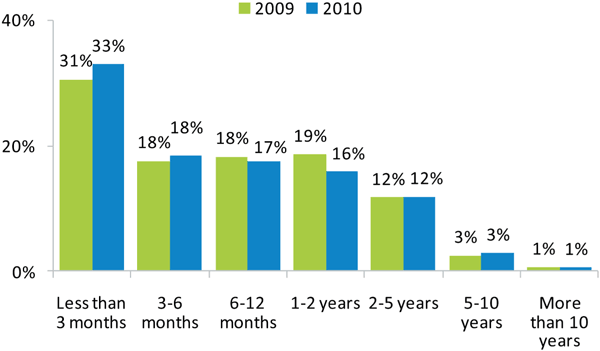
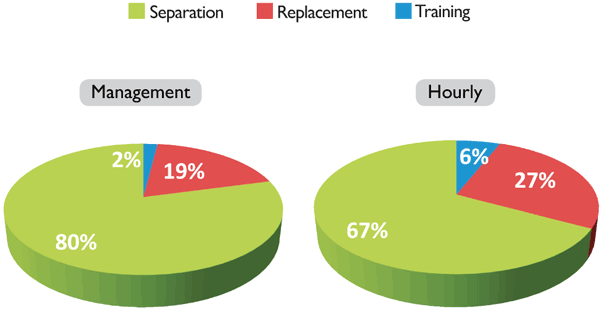
If the goal is to compete in the labor market, jacking up wages is one way to achieve the goal. But cost of labor ranks alongside cost of food as restaurants’ biggest expenditures, so it isn’t necessarily a variable with much room for growth.
McMullen says that doesn’t mean restaurants are doomed during times of low unemployment to busing in employees.
“The laws of supply and demand prevail, and the fact is that restaurants can operate and be profitable and get employees to work at the wages they offer,” he says.
The fact remains, however, that at the current wage levels, restaurants must withstand debilitating turnover, which will likely return to an above-100-percent average once unemployment drops.
As all restaurant operators know, turnover is expensive. It costs a lot of money to hire and train a new worker, and there is no guarantee the investment will pay long-term dividends. In fact, the annual turnover rate statistics seem to guarantee that it won’t.
There are restaurants that manage, against the odds, to minimize turnover. So far in 2011, only a quarter of restaurants have less than 60 percent turnover of nonsupervisory statistics, says McMullen, who also provided the other turnover statistics.
While more than half of their employees are still dropping off, restaurants able to keep turnover a full 20 percent below the current average will see “a world of difference in terms of what is hitting your bottom line,” McMullen says.
[pagebreak]
While restaurant chains don’t usually publicize their turnover rates, there are several large brands, including Starbucks, Chipotle, and Panera, that are widely recognized as leaders when it comes to keeping employees happy. What they all have in common, analysts say, is a hip brand that people want to be associated with and a culture that encourages entry-level employees to see themselves at the beginning of a career, not merely a job.
“The key to our success there is the strength of our people culture,” Chipotle spokesman Chris Arnold wrote in an e-mail.
Chipotle’s is a culture that is built on identifying its highest performers and developing them into future leaders. Arnold says the chain has been “relentlessly focused” on that strategy and the effort has paid off. Chipotle promotes more than 90 percent of its managers from within the company, he says.
“Ultimately, it’s just about creating a culture and an organization that people want to be a part of,” Arnold wrote.
Pinning down a business’ culture can be like nailing Jell-O to a wall, but it nonetheless has a significant impact on how employees, especially younger ones, feel about where they are working.
“Any organization that provides training programs, career-path development, above-minimum-wage labor rates, and provides a culture and camaraderie that a lot of younger Millennials are looking for” is covering all the bases, says Darren Tristano, executive vice president of restaurant consulting firm Technomic.
Besides Starbucks, Tristano cites In-N-Out Burger and Pal’s Sudden Service, a chain with locations in northeast Tennessee and southwest Virginia, as examples of restaurants whose corporate culture gives them a leg up over the competition.
While certain big brands have figured out how to minimize the age-old problem of high restaurant turnover, a small pizza concept with two locations in the Chicago area has all but eradicated it.
Nick Sarillo, owner of Nick’s Pizza & Pub, estimates that more than 90 percent of his 200 employees have been with the company for more than a year and that 40 percent have worked for him for more than five years.
How?
“If I had to say one thing, I would say it’s the culture of our company,” Sarillo says.
In this case, culture has a defined meaning. It means, for example, that Sarillo grants his employees unprecedented access to the company’s financial books so they can see exactly how the store is doing, and how they can help it do better.
Another aspect of the culture at Nick’s Pizza & Pub is that employees chart their own “self-development path” by choosing to be trained for different jobs and earning raises along the way.
For example, a dishwasher may sign up to learn how to make pizza dough, which comes with a 25-cent raise. Other certifications include rolling dough, manning the salad or sandwich stations, and running the register. After three certifications, employees get a $1 raise and a new black hat distinguishing expert workers.
The ability to proactively earn raises is, of course, a big reason Sarillo’s employees are so loyal to his company, but they also like the variety that comes with being able to handle almost any job in the restaurant.
“They know they’re not going to be stuck washing dishes every day,” Sarillo says.
Above all, Sarillo attributes the low-turnover rates at his restaurants to the career path open to every Nick’s Pizza & Pub employee, something he thinks more restaurants should offer their workers.
“Most restaurants don’t support the individual to be successful, or invest as much in training as we do,” Sarillo says.
“As a result, they end up paying for turnover instead of investing in retention. Why I spend money and time on training is because it’s an investment in retention that ultimately creates less turnover, higher sales, and better service.”
In a slow economy with high food costs, raising all entry-level wages is not an option, and it is difficult to compete on price and product, Sarillo says. The most effective weapon in a restaurant’s arsenal is service.
“So many companies keep looking at external motivators” like wage, Sarillo says. “Beyond that, the real opportunity is to tap into the internal motivation of the individual. Once you do that by creating a positive place to work … your employees will do anything for you.”
That loyalty will outlast even this recession and put restaurants like Nick’s Pizza & Pub in a good position once unemployment drops and the labor market tightens up.
It may require considerable foresight for restaurant operators to look to a time past today’s economic malaise, but it is something restaurants would be wise to do, says Roberta Matuson, president of Human Resource Solutions, based in Northampton, Massachusetts, and the author of Suddenly in Charge.
“When we do pull out of this recession—and we will eventually—the people that you’ve invested in and trained will be out the door unless you treat them right now,” she says.
It’s a warning worth heeding:
With gas at more than $3.50 a gallon, a 50-mile bus ride costs a bit more than it did 30 years ago.

